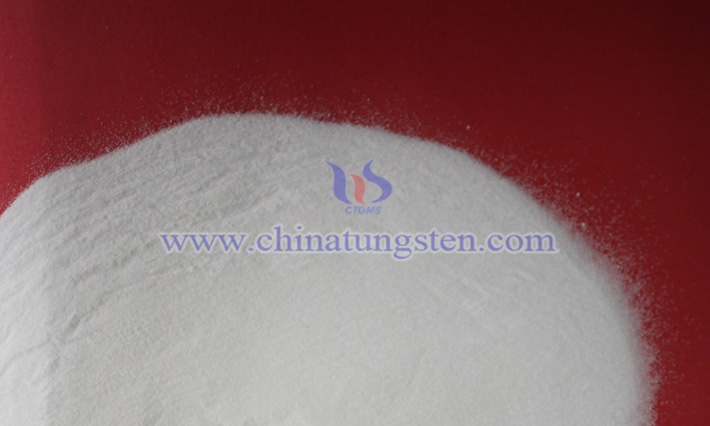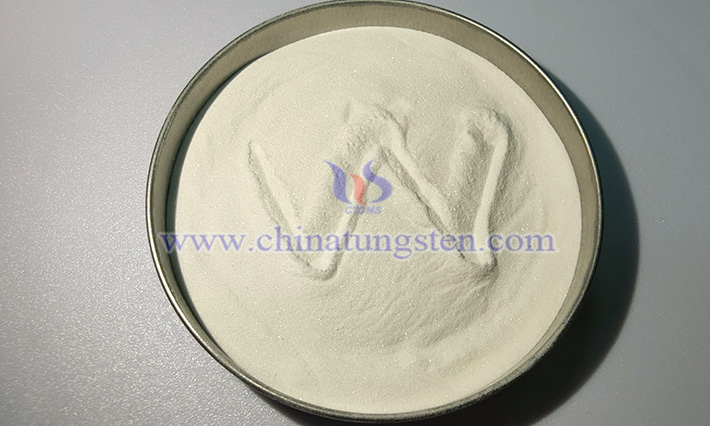Production Method of Ammonium Metatungstate
- Details
- Category: Tungsten Information
- Published on Thursday, 10 April 2025 17:40
- Written by Xiaoting
- Hits: 292
Ammonium metatungstate (AMT) is a white crystalline powder and an important tungsten chemical. It possesses good water solubility and high thermal stability, making it a key precursor in the preparation of metallic tungsten. Additionally, AMT is used in petrochemical industries to produce tungsten-based catalysts, enhances flame retardancy in fire-resistant fabrics, and improves various properties in the ceramics industry.
The production methods for AMT include the neutralization method, tungstic acid method, thermal decomposition method, solvent extraction method, and ion exchange method.

I. Neutralization Method for Preparing Ammonium Metatungstate
Using ammonium paratungstate (APT) and nitric acid as primary raw materials, APT is dissolved in deionized water and mixed with ammonium citrate to prepare a slurry with a WO₃ content of 12% to 30%. Subsequently, dilute nitric acid (3% to 5% concentration) is added in proportion, maintaining a solid-liquid ratio between 1:3 and 1:4, and the pH is adjusted to stabilize between 2 and 4. The solution is heated until its relative density reaches 1.18 to 1.20, then stirred at a constant temperature of 80 to 90°C for 4 hours. After the reaction, the solution undergoes aging treatment. The resulting clear liquid is concentrated to a WO₃ content of about 50%, filtered to remove insoluble impurities, further concentrated, cooled, and crystallized, and finally dried at 80°C to yield AMT. This method is simple and has low equipment requirements, but it necessitates strict safety measures for handling nitric acid and precise control of reaction conditions to ensure product purity.
II. Tungstic Acid Method for Preparing Ammonium Metatungstate
Tungstic acid is first dissolved in ammonia water and then added to boiling deionized water. Ammonia is gradually evaporated under continuous stirring and heating, adjusting the solution’s pH to 8. Acetic acid is added while the solution is boiling, followed by dilute nitric acid to adjust the pH to 2 to 4. Heating continues until the relative density reaches 1.5 to 2, at which point it stops. After cooling and filtration, ethanol is added to the filtrate and stirred thoroughly. Once precipitation is complete, the mixture is filtered again, and the resulting crystals are dried at 80°C and pulverized to produce AMT. This process requires multiple acid-base adjustments and stringent monitoring but effectively removes impurities, making it suitable for producing high-purity products.

III. Thermal Decomposition Method for Preparing Ammonium Metatungstate
Using APT as the raw material, a small amount of citric acid is added as a catalyst. After uniform mixing, the mixture is placed in a far-infrared rotary furnace and thermally decomposed at 200 to 280°C for about 1 hour. During this process, APT loses some ammonia and crystal water, with a weight loss rate controlled at 5% to 6%. The decomposition product is quickly turned into a slurry, and ammonia water is added to adjust the pH to 3 to 4, followed by boiling at 90°C. The solution is then evaporated and concentrated; when the AMT content reaches 50%, it can be used as a liquid product. If concentrated further to 20% of its original volume, solid products are obtained through crystallization, filtration, and granulation, or uniform spherical crystals can be produced via spray drying. This method requires high precision in temperature control but is well-suited for continuous production and large-scale preparation.
IV. Solvent Extraction Method for Preparing Ammonium Metatungstate
Using an ammonium tungstate solution as the raw material, an organic phase is prepared with di(2-ethylhexyl) phosphoric acid (DEHPA) or tributyl phosphate (TBP) mixed with kerosene. The extractant removes ammonium ions from the solution, lowering the pH to 2 to 4. After a boiling reaction to form an AMT solution, the final product is obtained through concentration, crystallization, filtration, separation, and drying. This method offers high selectivity and excellent separation efficiency, but attention must be paid to the recovery and reuse of the extractant to reduce costs and minimize environmental impact.
V. Ion Exchange Method for Preparing Ammonium Metatungstate
Starting with APT, the material is heated at 130 to 140°C for 1 to 8 hours. The resulting product is made into a slurry and boiled at 80 to 100°C for 2 to 6 hours to produce an AMT solution, which is then processed through concentration, crystallization, filtration, separation, and drying to obtain the final product. Alternatively, electrodialysis can be used, with ammonium tungstate or APT as the raw material. In an electrodialysis unit, an electric current drives ammonium ions through an anion exchange membrane into the cathode chamber, increasing the AMT concentration in the anode chamber. The solution is collected from the cathode chamber and further processed into the final product. The ion exchange method is more complex but excels in enhancing product purity, making it particularly suitable for high-end applications with stringent impurity requirements.
- Chinatungsten Online: ammonium-metatungstate.com
- CTIA GROUP LTD: en.ctia.group
- Tungsten News & Price: www.ctia.com.cn
- Molybdenum News & Price: news.molybdenum.com.cn
- Tel.: 86 592 5129696; Email: sales@chinatungsten.com





 sales@chinatungsten.com
sales@chinatungsten.com